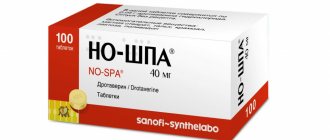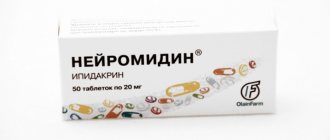Principle of action of Gliatilin
The action of the drug is aimed at neural connections in the human brain. After being absorbed into the blood, the active substance, choline alfoscerate, reaches the brain, where it enters into chemical reactions. As a result of the formation of bonds, glycerol phosphate and choline are released. During the biotransformation process, phosphatidylcholine and acetylcholine are synthesized. The first substance increases the elasticity of cell membranes and their permeability. And the second substance is one of the most important nerve mediators.
Taking Gliatilin activates blood circulation processes in the brain, which ensures rapid restoration of lost functions. Most of the substance is eliminated by the respiratory system, along with carbon dioxide. Residues - with waste products.
Operating principle
The main component Choline alfoscerate stimulates central cholinergic receptors, improves cerebral circulation and metabolism in the central nervous system. This compound ensures the production of special components in neuronal membranes - phosphatidylcholine and acetylcholine. When taking Choline alfoscerate, reticular formation is stimulated and the plasticity of neuronal membranes increases.
The combination of the described effects leads to the following improvements in the patient’s condition:
- Increased mood;
- The emergence of emotional stability;
- Optimization of behavioral reactions;
- Increasing concentration, ability to perceive, remember and reproduce information received from outside.
In case of TBI, the main component of choline alfoscerate improves the bioelectrical activity of the brain and stimulates blood flow in the affected area. This helps reduce neurological symptoms.
In the body, choline alfoscerate is broken down into 2 components:
- glycerophosphate;
- choline
The substance is absorbed into tissues by 88%, concentrated mainly in the brain. It is excreted from the body by the lungs (85% is exhaled in the form of carbon dioxide) and by the kidneys and liver (up to 15%).
Indications for the use of Gliatilin
Gliatilin is prescribed for diagnosed disorders of the blood supply to the brain, which can be manifested by confusion, memory loss and other typical symptoms. Diseases and conditions that are direct indications for taking the drug:
- traumatic brain injuries leading to impaired consciousness, post-traumatic coma, dizziness;
- ischemic stroke, leading to necrosis of parts of the brain;
- dementia;
- age-related speech disorders;
- bouts of disorientation.
Patients taking gliatilin for long courses showed improvement in their condition, restoration of thought processes, and return of memory.
Alpha GPC by Mr.Lt.Nootropics
This supplement is an analogue of Gliatilin, but with a reduced concentration of choline alfoscerate. It belongs to the category of nootropic drugs and cholineergics (helps the body produce choline necessary for normal functioning).
Indications for taking Alpha GPC are the following symptoms:
- Decreased concentration;
- Memory impairment;
- Frequent dizziness;
- Disturbances in brain function caused by oxygen starvation;
- Mental disorders arising from prolonged use of alcohol;
- Psychoorganic syndrome.
The result of taking Alpha GPC is an improvement in mood and general well-being, elimination of apathy, chronic fatigue syndrome, irritability, and anxiety. Concentration improves significantly, the level of stress resistance and the speed of memorizing information increases.
Alpha GPC
1999 rub.
Alpha GPC is available in powder or capsule form for oral administration. Before use, consultation with a medical specialist is required.
Instructions for use of Gliatilin
The instructions recommend long-term use of the drug, since restoration of brain function takes time. The minimum course is 3 months. It can be extended up to six months. As a rule, patients are prescribed the drug in the form of capsules for oral administration. But due to the fact that the capsules themselves are quite large, not every patient can absorb them, for example:
- child;
- a patient with a swallowing reflex disorder;
- patients who have suffered an ischemic stroke with a high degree of severity of damage.
In addition, unconscious and comatose patients are also unable to swallow the drug. In such cases, an alternative is prescribed - a solution for drip administration. 1 ampoule is diluted with 50 ml of saline solution. The rate of administration is no more than 80 drops per minute.
When prescribing capsules containing 400 mg of the active substance, the course consists of two to three doses per day. The medicine should be taken after meals. Each capsule is covered with a dense layer of soluble shell, which protects the active components from the aggressive environment of gastric juice and duodenum. Once in the large intestine, the coating disintegrates and releases the drug, from where it is easily absorbed into the bloodstream and reaches the brain. Therefore, the idea of cutting the capsule and squeezing the contents into a puree-like food to make it easier to take is impractical. The acidic environment of the stomach will destroy all the benefits of the substance.
Buy Gliatilin solution intravenously and intramuscularly 1g 4ml No. 3 in pharmacies
Gliatilin Buy Gliatilin in pharmacies DOSAGE FORMS solution for intravenous and intramuscular administration 250 mg/ml solution for injection 1g
MANUFACTURERS Italfarmaco S.p.A. packaged by Pharmacor Production (Italy) Italfarmaco S.p.A. (Italy)
GROUP Nootropic drugs
COMPOSITION Active substance: Choline alfoscerate.
INTERNATIONAL NON-PROPENTED NAME Choline alfoscerate
SYNONYMS Gleatser, Delecit, Noocholin Rompharm, Choline alfoscerate, Holitylin, Cerepro, Cereton
PHARMACOLOGICAL ACTION Pharmacodynamics. Gliatilin - choline alfoscerate is a centrally acting cholinomimetic with a predominant effect on the central nervous system. The drug contains 40.5% choline, released from a compound in the brain; choline is involved in the biosynthesis of acetylcholine (one of the main mediators of nervous excitation). Alphoscerate is biotransformed to glycerophosphate, which is a precursor to phospholipids. Acetylcholine has a positive effect on the transmission of nerve impulses, and glycerophosphate is involved in the synthesis of phosphatidylcholine (membrane phospholipid), resulting in improved membrane elasticity and receptor function. The drug increases cerebral blood flow, enhances metabolic processes and activates the structures of the reticular formation of the brain, and also restores consciousness in case of traumatic brain injury. It has a preventive and corrective effect on the factors of involutional psychoorganic syndrome, such as changes in the phospholipid composition of neuronal membranes and a decrease in cholinergic activity. Thus, pharmacodynamic studies have shown that the drug acts on: synaptic, including cholinergic transmission of nerve impulses (neurotransmission); plasticity of the neuronal membrane; receptor function Pharmacokinetics. Absorption when taken orally - 88%; easily penetrates the blood-brain barrier, accumulates mainly in the brain (concentration in the brain reaches 45% of the level in the blood), lungs and liver; 85% is excreted by the lungs in the form of carbon dioxide, the rest (15%) is excreted by the kidneys and through the intestines. Does not affect the reproductive cycle, does not have teratogenic or mutagenic effects.
INDICATIONS FOR USE Acute period of traumatic brain injury, mainly with brain stem lesions (including impaired consciousness, coma); disorders of cerebral circulation of the ischemic type (acute and recovery period) and hemorrhagic type (recovery period), degenerative and involutional psychoorganic syndromes and consequences of cerebrovascular insufficiency, such as primary and secondary disorders of mnestic functions, characterized by memory impairment, confusion, disorientation, decreased motivation , initiative and decreased ability to concentrate; changes in the emotional and behavioral sphere: emotional lability, increased irritability, decreased interest, senile pseudomelancholy; multi-infarct dementia.
CONTRAINDICATIONS Hypersensitivity to the components of the drug. Use during pregnancy and lactation.
SIDE EFFECT Nausea (as a result of dopaminergic activation), in this case the dose of the drug is reduced. Allergic reactions are possible. As a rule, the drug is well tolerated even with long-term use.
INTERACTIONS No drug interactions have been established.
METHOD OF APPLICATION AND DOSAGE Injections intramuscularly or intravenously (drip). For adults. For acute conditions: intramuscularly at a dose of 1000 mg (1 ampoule) per day or intravenously from 1000 mg to 3000 mg per day. When administered intravenously, the contents of one ampoule (4 ml) are diluted in 50 ml of physiological solution, the infusion rate is 60-80 drops per minute. The duration of treatment is usually 10 days, but if necessary, treatment can be continued until positive dynamics appear and it is possible to switch to oral capsules.
OVERDOSE Symptoms: nausea. If this symptom appears, it is recommended to reduce the dose of the drug.
SPECIAL INSTRUCTIONS Impact on the ability to drive a car or other machinery. Does not affect the patient's ability to engage in potentially hazardous activities.
STORAGE CONDITIONS Store out of the reach of children at a temperature not exceeding 25 C.
Price for the drug Gliatilin
In the absence of Gliatilin in the pharmacy, the drug can be replaced with no less effective analogues with the same active ingredient:
- Choline alfoscerate. Sold in the form of a solution for intramuscular or drip administration. Each ampoule contains 250 mg/ml of active substance, ampoules are 4 ml each. There are 10 pieces in a package. The cost of this analogue is slightly higher than 550 rubles per package.
- Nooholin Rimpharm. Ampoules do not differ in volume and content of active substance. There are usually 3 ampoules in a package, the cost of the drug in the described dosage is from 350 rubles per package.
- Cereton. Available in capsules, each dose unit contains 400 mg of the active ingredient. A package of 56 capsules costs an average of 1,400 rubles. The solution for intravenous and intramuscular administration is packaged in 4 ml ampoules, each of which contains 0.25 ml of the substance. A pack of 5 ampoules can be purchased for 580 rubles.
- Holitylin 400 mg. Sold in capsules, 28 or 14 pieces per package. The dosage and number of doses does not differ from the prescribed regimen for taking Gliatilin. The cost of a package containing 14 doses varies from 405 rubles.
- Cerepro. It can be found both in ampoules and capsules. The amount of active substance in 1 dose does not differ from what is contained in analogues. A package of 28 capsules is sold at a price of 1,000 rubles.
Pharmacy analogues of Gliatilin
The following drugs are generics of this drug:
1. Cerepro. The average price in Moscow is 523 rubles. The main component is glycerylphosphorylcholine hydrate. In addition to cognitive disorders and the recovery period after TBI, it is prescribed in the case of therapy after hemorrhagic stroke and for chronic disorders in the blood circulation of the brain.
2. Cereton. The average cost in the Moscow region is fixed at 245 rubles. Indications for use are similar to Gliatilin. Cereton is available in the form of an injection solution (the main active ingredient is glycerylphosphorylcholine hydrate) and in the form of capsules (the main component is choline alphoscerate).
3. Cholitilin. The average price in Moscow pharmacies fluctuates at 395 rubles. In the solution for injection, the main substance is choline alfoscerate polyhydrate, and in capsules it is choline alfoscerate hydrate. Indications for use are similar to those established for Gliatilin. In addition, Holitylin is used in rehabilitation therapy after multi-infarction dementia.
The presented generics have similar side symptoms. These include nausea, the appearance of an allergic rash and other protective reactions.
Replacing injections with capsules
When the patient is unable to swallow on his own or his mental state is impaired, due to which he refuses to take pills, intramuscular or drip administration is prescribed. This treatment regimen can be replaced with capsules if the patient is recovering and his swallowing function allows him to take large pieces of food. The same applies to patients in a coma - as soon as the patient regains consciousness and begins to feed on his own, Gliatilin is transferred to capsule form. This allows the patient to go home under the supervision of a local specialist.

